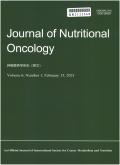Multivariate Analysis of Prognosis in Patients with Pancreatic Cancer
引用次数: 0
Abstract
: Objective Pancreatic cancer is a highly malignant digestive system tumor. The prognosis of pancreatic cancer may be affected by many factors. But there is a lack of research on the multivariate analysis of prognostic factors of pancreatic cancer. This study aimed to explore the factors that multivariate influence the prognosis of pancreatic cancer. Methods We conducted a retrospective cohort study using electronic medical record database from The First Hospital of Jilin University from January 2014 to December 2016. Clinical information, such as TNM stage, serum tumor markers, serum albumin and the patient-generated subjective global assessment (PG-SGA), were collected. Ka-plan-Meier method was used to calculate survival rate. The survival curve was compared with the Log-rank test. A multivariate analysis was performed for each prognostic factor using the Cox proportional hazards model. The significance level was 0.05. Results 1. The median overall survival time (OS) of 493 patients was 10 months. The 1-year, 2-year, and 3-year cumulative survival rates were 41.5%, 20.6%, and 9.9%, respectively. Univariate survival analysis revealed that TNM stage ( P < 0.001), treatment regimen ( P < 0.001), CA125 ( P < 0.001), the level of serum albumin ( P = 0.014), and nutritional status ( P = 0.006) were significantly correlated with prognosis of pancreatic cancer. COX proportional hazards regression model showed that TNM stage ( P = 0.038), Carbonhydrate antigen 125 (CA125) ( P = 0.003) and the level of serum albumin were independent factors affecting the median OS. The prognosis of patients with Ⅳ stage, elevated levels of serum albumin group and elevated levels of CA125 group were poor. 2. Seventy-three patients with pancreatic cancer underwent surgical resection. The median postoperative survival time was 28 months. The 1-year, 2-year, and 3-year cumulative survival rates were 74.4%, 47.7%, and 21.4%, respectively. Univariate analysis revealed that TNM stage ( P = 0.032), pathological type ( P = 0.012), hypoglycemia ( P = 0.040), CA125 ( P < 0.001), were significant ly correlated with prognosis of pancreatic cancer. COX proportional hazards regression model showed that TNM stage ( P = 0.008), pathological type ( P = 0.045) and CA125 ( P = 0.017), were independent prognostic factors after resection of pancreatic cancer. The prognosis of patients with advanced stage, non-ductal adenocarcinoma and elevated levels of CA125 group was poor. Conclusions 1. TNM stage, CA125 and serum albumin are independent prognostic factors for the overall survival of patients with pancreatic cancer. 2. TNM stage, pathological type, and CA125 are independent prognostic factors for the postoperative survival time in patients with pancreatic cancer after resection.胰腺癌患者预后的多因素分析
目的胰腺癌是一种高度恶性的消化系统肿瘤。影响胰腺癌预后的因素很多。但对胰腺癌预后因素的多因素分析尚缺乏研究。本研究旨在探讨影响胰腺癌预后的多因素因素。方法采用2014年1月至2016年12月吉林大学第一医院电子病案数据库进行回顾性队列研究。收集临床信息,如TNM分期、血清肿瘤标志物、血清白蛋白和患者主观整体评估(PG-SGA)。采用Ka-plan-Meier法计算存活率。生存曲线比较采用Log-rank检验。使用Cox比例风险模型对每个预后因素进行多变量分析。显著性水平为0.05。结果1。493例患者的中位总生存期(OS)为10个月。1年、2年和3年累计生存率分别为41.5%、20.6%和9.9%。单因素生存分析显示,TNM分期(P < 0.001)、治疗方案(P < 0.001)、CA125 (P < 0.001)、血清白蛋白水平(P = 0.014)、营养状况(P = 0.006)与胰腺癌预后有显著相关。COX比例风险回归模型显示,TNM分期(P = 0.038)、碳水化合物抗原125 (CA125) (P = 0.003)和血清白蛋白水平是影响中位OS的独立因素。Ⅳ期患者、血清白蛋白升高组、CA125升高组预后较差。2. 73例胰腺癌患者接受了手术切除。术后中位生存时间为28个月。1年、2年和3年累计生存率分别为74.4%、47.7%和21.4%。单因素分析显示,TNM分期(P = 0.032)、病理类型(P = 0.012)、低血糖(P = 0.040)、CA125 (P < 0.001)与胰腺癌预后有显著相关。COX比例风险回归模型显示,TNM分期(P = 0.008)、病理类型(P = 0.045)、CA125 (P = 0.017)是胰腺癌切除术后预后的独立影响因素。晚期非导管腺癌患者及CA125水平升高组预后较差。结论1。TNM分期、CA125和血清白蛋白是胰腺癌患者总生存期的独立预后因素。2. TNM分期、病理分型、CA125是影响胰腺癌术后生存时间的独立预后因素。
本文章由计算机程序翻译,如有差异,请以英文原文为准。
求助全文
约1分钟内获得全文
求助全文

 求助内容:
求助内容: 应助结果提醒方式:
应助结果提醒方式:


